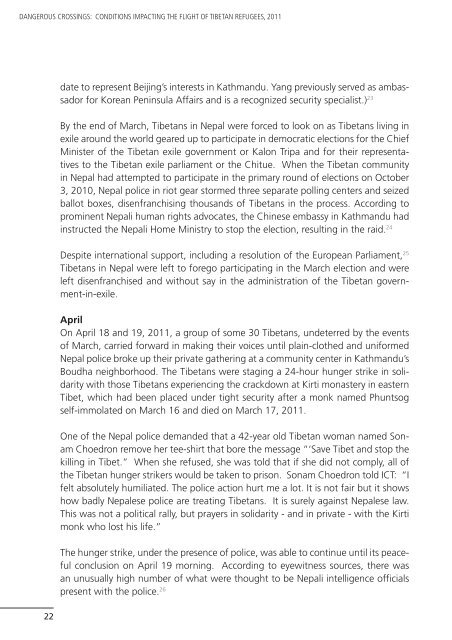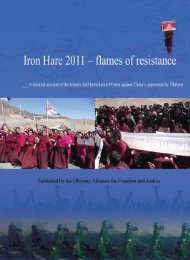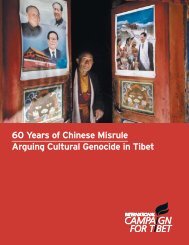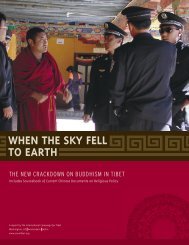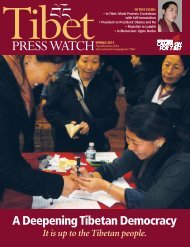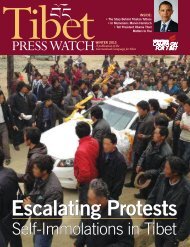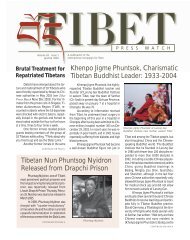DANGEROUS CROSSING: - International Campaign for Tibet
DANGEROUS CROSSING: - International Campaign for Tibet
DANGEROUS CROSSING: - International Campaign for Tibet
Create successful ePaper yourself
Turn your PDF publications into a flip-book with our unique Google optimized e-Paper software.
<strong>DANGEROUS</strong> <strong>CROSSING</strong>S: CONDITIONS IMPACTING THE FLIGHT OF TIBETAN REFUGEES, 2011<br />
22<br />
date to represent Beijing’s interests in Kathmandu. Yang previously served as ambassador<br />
<strong>for</strong> Korean Peninsula Affairs and is a recognized security specialist.) 23<br />
By the end of March, <strong>Tibet</strong>ans in Nepal were <strong>for</strong>ced to look on as <strong>Tibet</strong>ans living in<br />
exile around the world geared up to participate in democratic elections <strong>for</strong> the Chief<br />
Minister of the <strong>Tibet</strong>an exile government or Kalon Tripa and <strong>for</strong> their representatives<br />
to the <strong>Tibet</strong>an exile parliament or the Chitue. When the <strong>Tibet</strong>an community<br />
in Nepal had attempted to participate in the primary round of elections on October<br />
3, 2010, Nepal police in riot gear stormed three separate polling centers and seized<br />
ballot boxes, disenfranchising thousands of <strong>Tibet</strong>ans in the process. According to<br />
prominent Nepali human rights advocates, the Chinese embassy in Kathmandu had<br />
instructed the Nepali Home Ministry to stop the election, resulting in the raid. 24<br />
Despite international support, including a resolution of the European Parliament, 25<br />
<strong>Tibet</strong>ans in Nepal were left to <strong>for</strong>ego participating in the March election and were<br />
left disenfranchised and without say in the administration of the <strong>Tibet</strong>an government-in-exile.<br />
April<br />
On April 18 and 19, 2011, a group of some 30 <strong>Tibet</strong>ans, undeterred by the events<br />
of March, carried <strong>for</strong>ward in making their voices until plain-clothed and uni<strong>for</strong>med<br />
Nepal police broke up their private gathering at a community center in Kathmandu’s<br />
Boudha neighborhood. The <strong>Tibet</strong>ans were staging a 24-hour hunger strike in solidarity<br />
with those <strong>Tibet</strong>ans experiencing the crackdown at Kirti monastery in eastern<br />
<strong>Tibet</strong>, which had been placed under tight security after a monk named Phuntsog<br />
self-immolated on March 16 and died on March 17, 2011.<br />
One of the Nepal police demanded that a 42-year old <strong>Tibet</strong>an woman named Sonam<br />
Choedron remove her tee-shirt that bore the message “‘Save <strong>Tibet</strong> and stop the<br />
killing in <strong>Tibet</strong>.” When she refused, she was told that if she did not comply, all of<br />
the <strong>Tibet</strong>an hunger strikers would be taken to prison. Sonam Choedron told ICT: “I<br />
felt absolutely humiliated. The police action hurt me a lot. It is not fair but it shows<br />
how badly Nepalese police are treating <strong>Tibet</strong>ans. It is surely against Nepalese law.<br />
This was not a political rally, but prayers in solidarity - and in private - with the Kirti<br />
monk who lost his life.”<br />
The hunger strike, under the presence of police, was able to continue until its peaceful<br />
conclusion on April 19 morning. According to eyewitness sources, there was<br />
an unusually high number of what were thought to be Nepali intelligence officials<br />
present with the police. 26


